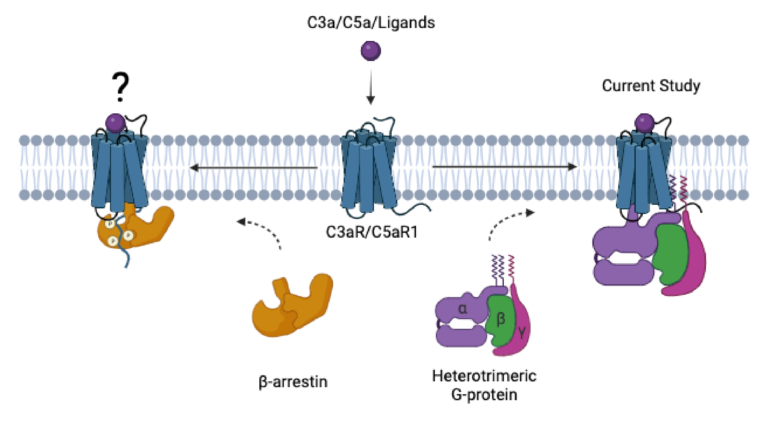Complementing the Immune System: A Structural Perspective
Work done in the lab of Dr. Cornelius Gati at Bridge Institute, University of Southern California, Los Angeles, USA and Prof. Arun K Shukla Lab at IIT Kanpur, India
Dr. Ravi Yadav is a postdoctoral fellow in Dr. Cornelius Gati’s laboratory at Bridge Institute, Molecular and Computational Biology Section, Department of Biological Sciences, University of Southern California, Los Angeles, USA. Ravi completed his bachelor’s degree in biotechnology from the Indian Institute of Technology Roorkee, India. He received his Ph.D. in biomolecular structure and biophysics from Purdue University, USA. As a postdoctoral fellow, he is investigating complement receptor signaling and neurotransmitter transporters.
Author Interview
How would you explain your research outcomes to the non-scientific community?
To combat foreign pathogens, our body employs the immune system through the activation of a series of steps known as the complement cascade. Malfunction of the complement system has been linked to various autoimmune and neurogenerative diseases, cancer, and COVID-19. Thus, the fundamental nature of the complement system in various pathologies makes pathway intermediates promising drug targets.
Activation of the complement system results in the formation of anaphylatoxins C3a and C5a. These anaphylatoxins activate receptors on the cell surface that belong to a family of membrane proteins known as G-protein coupled receptors (GPCRs). Anaphylatoxin C3a activates C3aR, whereas C5a activates C5aR1 and C5aR2. These receptors are activated by their respective ligands and stimulate intracellular signaling cascades. However, the mechanism of the ligand binding and activation remains elusive.
To understand how these receptors are activated, a structural perspective is required. Our research utilizes various methods to investigate the complement cascade at the individual protein level. We determined the atomic structures of these receptors in complex with their respective ligands and heterotrimeric G-proteins. Our research provided insights into how these receptors recognize their ligands and get activated.

“This information can be utilized for the identification of new ligands (agonist/antagonist/inverse agonists), which can be used as tool compounds to investigate the immune system at the physiological level.”
How do these findings contribute to your research area?
Advances in computational methods allow for the screening of billions of compounds against a target to identify new molecules that can be further developed as therapeutic agents. However, a pre-requisite for these applications is structural details of the target at the atomic level. Our study not only explains decades of previous observations but also enables fundamental insights into what the complement receptors look like and how they interact with their ligands. This information can be utilized for the identification of new ligands (agonist/antagonist/inverse agonists), which can be used as tool compounds to investigate the immune system at the physiological level. These compounds may also hold the potential to be developed into the next generation of drugs targeting the immune system to treat autoimmune, inflammatory, and infectious diseases.
What was the exciting moment during your research?
As an undergraduate, I studied biotechnology engineering. However, my true interest lay in the more fundamental aspects of biology. For example, the complement system is an integral component of the immune system; it is taught in any immunology course. However, there is limited research on what the structures of these receptors look like. So, when I had an opportunity to participate in the study examining these receptors at the molecular level, I was very excited and eager to contribute to the ongoing efforts in Dr. Shukla and Dr. Gati’s laboratory. While the journey was challenging, it was also incredibly exciting. It’s too hard to pick just one excitable moment though. I enjoyed every stage of the project, from data collection to solving the GPCR structures. It was also exciting when our paper was accepted for publication, which is my first publication as a postdoctoral fellow.
What do you hope to do next?
In the near future, I will continue to investigate the unanswered questions regarding the complement system. In the long term, I want to transition to an independent researcher as a faculty member at a university. I want to continue research on membrane proteins to investigate the structural-functional relationship and develop therapeutics to treat diseases.
Where do you seek scientific inspiration from?
My scientific inspiration comes from many different sources. As a kid, I was fascinated by former president Dr. APJ Abdul Kalam and how he contributed to Indian science by developing an independent India that could take on modern challenges. In high school, I became interested in physics because of the passion my teacher had for the subject. I am inspired by my colleagues who are contributing to cutting-edge research. I am inspired by great scientists and scholars I read about and how they showed perseverance and determination to investigate fundamental questions in science.
How do you intend to help Indian science improve?
India is a major contributor to biophysics and structural biology research. In the future, I wish to mentor the next generation of Indian students to tackle the fundamental questions in the life sciences. I also envision a collaborative network of Indian researchers nationwide to contribute to both basic and applied science.
Reference: Yadav MK‡, Maharana J‡, Yadav R‡, Saha S‡, Sarma P‡ et al. Molecular basis of anaphylatoxin binding, activation, and signaling bias at complement receptors. Cell. 2023 Oct 26;186(22):4956-4973.e21. doi: 10.1016/j.cell.2023.09.020. Epub 2023 Oct 17. PMID: 37852260. (‡ denotes equal contribution)
Edited by: Ritvi Shah
Biopatrika: Bringing Science to Society
© Biopatrika 2023 All Rights Reserved.

